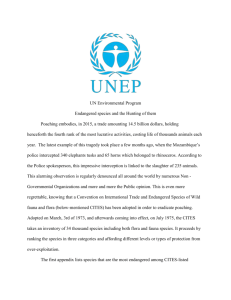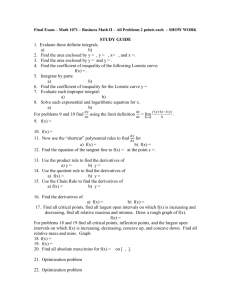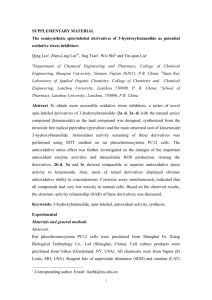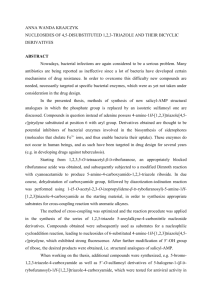PC12 Doc. 9.1 - English
advertisement
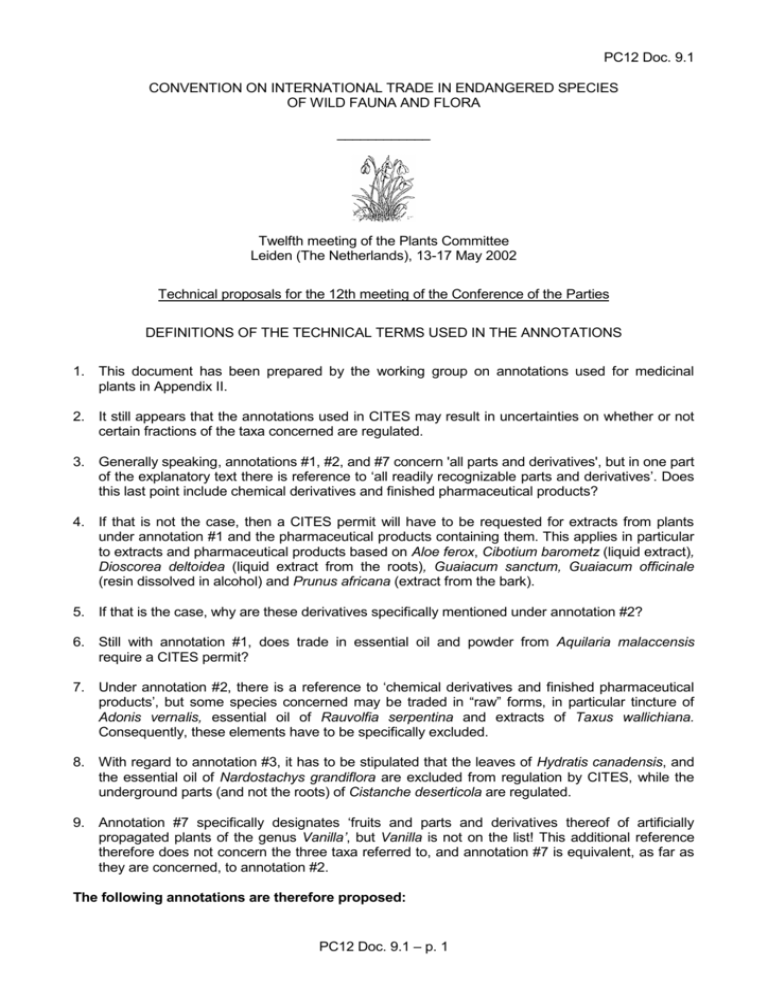
PC12 Doc. 9.1 CONVENTION ON INTERNATIONAL TRADE IN ENDANGERED SPECIES OF WILD FAUNA AND FLORA ____________ Twelfth meeting of the Plants Committee Leiden (The Netherlands), 13-17 May 2002 Technical proposals for the 12th meeting of the Conference of the Parties DEFINITIONS OF THE TECHNICAL TERMS USED IN THE ANNOTATIONS 1. This document has been prepared by the working group on annotations used for medicinal plants in Appendix II. 2. It still appears that the annotations used in CITES may result in uncertainties on whether or not certain fractions of the taxa concerned are regulated. 3. Generally speaking, annotations #1, #2, and #7 concern 'all parts and derivatives', but in one part of the explanatory text there is reference to ‘all readily recognizable parts and derivatives’. Does this last point include chemical derivatives and finished pharmaceutical products? 4. If that is not the case, then a CITES permit will have to be requested for extracts from plants under annotation #1 and the pharmaceutical products containing them. This applies in particular to extracts and pharmaceutical products based on Aloe ferox, Cibotium barometz (liquid extract), Dioscorea deltoidea (liquid extract from the roots), Guaiacum sanctum, Guaiacum officinale (resin dissolved in alcohol) and Prunus africana (extract from the bark). 5. If that is the case, why are these derivatives specifically mentioned under annotation #2? 6. Still with annotation #1, does trade in essential oil and powder from Aquilaria malaccensis require a CITES permit? 7. Under annotation #2, there is a reference to ‘chemical derivatives and finished pharmaceutical products’, but some species concerned may be traded in “raw” forms, in particular tincture of Adonis vernalis, essential oil of Rauvolfia serpentina and extracts of Taxus wallichiana. Consequently, these elements have to be specifically excluded. 8. With regard to annotation #3, it has to be stipulated that the leaves of Hydratis canadensis, and the essential oil of Nardostachys grandiflora are excluded from regulation by CITES, while the underground parts (and not the roots) of Cistanche deserticola are regulated. 9. Annotation #7 specifically designates ‘fruits and parts and derivatives thereof of artificially propagated plants of the genus Vanilla’, but Vanilla is not on the list! This additional reference therefore does not concern the three taxa referred to, and annotation #7 is equivalent, as far as they are concerned, to annotation #2. The following annotations are therefore proposed: PC12 Doc. 9.1 – p. 1 To replace #1 and #2 #A Designates all parts and derivatives, except: a) seeds, spores and pollen (including pollinia); b) seedling or tissue cultures obtained in vitro, in solid or liquid media, transported in sterile containers; c) cut flowers of artificially propagated plants; and d) chemical derivatives and finished pharmaceutical products including colouring matter, essential oils and vegetal extracts. For the following taxa: Aloe ferox Cibotium barometz Dioscorea deltoidea Guaiacum officinale Guaiacum sanctum Prunus africana Adonis vernalis Podophyllum hexandrum Rauvolfia serpentina Taxus wallichiana #B Designates all parts and derivatives, except: a) seeds, spores and pollen (including pollinia); b) seedling or tissue cultures obtained in vitro, in solid or liquid media, transported in sterile containers; c) cut flowers of artificially propagated plants; d) chemical derivatives and finished pharmaceutical products including colouring matter, essential oils and vegetal extracts; and e) powdered parts of plants. For the following taxon: Aquillaria malaccensis To replace #3 #C Designates roots and underground parts, but not aerial parts, of plants used primarily in perfumery and pharmacy, fresh or dried, whether or not cut, crushed or powdered, except: a) manufactured parts or derivatives such as powders, pills, extracts, tonics, teas and confectionery; and b) chemical derivatives and finished pharmaceutical products including colouring matter, essential oils and vegetal extracts. For the following taxa: PC12 Doc. 9.1 – p. 2 Cistanche deserticola Hydratis canadensis Nardostachys grandiflora Panax ginseng Panax quinquefolius Picrorhiza kurrooa To replace #7 #E Designates all parts and derivatives, except: a) seeds, spores and pollen (including pollinia); b) seedling or tissue cultures obtained in vitro, in solid or liquid media, transported in sterile containers; c) cut flowers of artificially propagated plants. For the following taxa: Bletilla striata Dendrobium spp. Gastrodia elata PC12 Doc. 9.1 – p. 3 PC12 Doc. 9.1 – p. 4 PC12 Doc. 9.1 Annex CITES wording Annotation no. PC12 Doc. 9.1 – p. 5 Nomenclature in the Customs system: Fraction excluded from CITES control for: - Seeds, spores and pollen #1, #2, #7 (including pollinia) - Seeds of herbaceous plants cultivated principally for their flowers (II 1209.30). Pollen is not specifically designated CITES - Seedling or tissue #1, #2, #7 cultures obtained in vitro, in solid or liquid media, transported in sterile containers - Cut flowers of artificially #1, #2, #7 propagated plants Pollen is not specifically designated - Chemical derivatives #2 - Finished pharmaceutical products #2 Adonis, Podophyllum, Rauvolfia, Taxus HS - Whole and sliced roots and parts of roots #3 - Manufactured parts or derivatives such as #3 - Pharmaceutical products (VI 30) tanning or dyeing extracts (VI 32), essential oils and resinoids (VI 33) - Pharmaceutical products, medicaments consisting of two or more constituents which have been mixed together (VI 3004 and VI 3003) - Plants and parts of plants (including seeds and fruits), of a kind used primarily in perfumery and pharmacy or for insecticidal, fungicidal or similar purposes, fresh or dried, whether or not cut, crushed or powdered (II 1211), Ginseng panax (II 1211 20 00), other (II 1211 90 95) Not specifically designated Aloe, Aquilaria, Cibotium, Dioscorea, Guaiacum, Prunus, Adonis, Podophyllum, Rauvolfia, Taxus, Bletilla, Dendrobium, Gastrodia Aloe, Aquilaria, Cibotium, Dioscorea, Guaiacum, Prunus, Adonis, Podophyllum, Rauvolfia, Taxus, Bletilla, Dendrobium, Gastrodia Aloe, Aquilaria, Cibotium, Dioscorea, Guaiacum, Prunus, Adonis, Podophyllum, Rauvolfia, Taxus, Bletilla, Dendrobium, Gastrodia Adonis, Podophyllum, Rauvolfia, Taxus - Cut flowers and flower buds of a kind suitable for bouquets or for ornamental purposes, fresh (II 0603.10) Fraction regulated by CITES for: Notes: - Pollen is not mentioned in HS CITES CITES HS, VI 30 only (1) Cistanche, Hydratis, Nardostachys, Panax, Picrorhiza Cistanche, Hydratis, Nardostachys, Panax, Choice: HS (2) CITES - See in HS : II 1404.10 CITES wording powders, pills, extracts, tonics, teas and confectionery - wood-chips and unprocessed broken material PC12 Doc. 9.1 – p. 6 - Fruits and parts and derivatives thereof of artificially propagated plants of the genus Vanilla Annotation no. #6 #7 Nomenclature in the Customs system: - Plants and parts of plants (including seeds and fruits), of a kind used primarily in perfumery and pharmacy or for insecticidal, fungicidal or similar purposes, fresh or dried, whether or not cut, crushed or powdered (II 1211), other (II 1211 90 95) Not specifically designated Fraction excluded from CITES control for: Picrorhiza Fraction regulated by CITES for: Pterocarpus Bletilla, Dendrobium, Gastrodia Choice: HS (3) CITES Notes:


